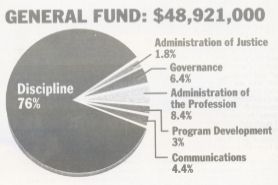The State Bar of California starts the new year with
a mix of renewed hope and a measure of uncertainty. The hope is generated by a legislative
authorization to collect $395 from most of California’s 135,000-plus active lawyers,
which, combined with the dues of inactive members, is expected to produce approximately
$41.8 million in membership revenue in 2000. The remaining funding to balance the $48.9
million budget comes from non-membership dues sources, primarily earned income.
 The uncertainty comes from the number of attorneys who voluntarily paid “full”
dues two years ago and now are opting to take a credit on this year’s dues. In
addition, many lawyers are taking advantage of a provision of the 2000 fee bill permitting
reduced dues for lower income earners. The uncertainty comes from the number of attorneys who voluntarily paid “full”
dues two years ago and now are opting to take a credit on this year’s dues. In
addition, many lawyers are taking advantage of a provision of the 2000 fee bill permitting
reduced dues for lower income earners.
This year’s budget is $20 million smaller than the budget for
1997, the last year the bar was legislatively authorized to collect dues. Despite that
dramatic reduction, we now have the ability to reinstate programs which benefit our
members and protect the public. We do so with a significantly reduced staff and
streamlined procedures.
As you can see in the accompanying chart, 76 percent of the bar’s
budget — $37.2 million — is allocated to the discipline operation. $28.4 million
of that is devoted to enforcement, with the remainder split among the State Bar Court, fee
arbitration and professional competence.
 Administration
of justice ($905,000) includes support for the Commission on Judicial Nominees Evaluation
(JNE) and research and court reform. Governance ($3.2 million) funds are earmarked for the
board of governors and its legislative efforts ($275,000). Administration
of justice ($905,000) includes support for the Commission on Judicial Nominees Evaluation
(JNE) and research and court reform. Governance ($3.2 million) funds are earmarked for the
board of governors and its legislative efforts ($275,000).
Administration of the profession ($4.1 million) includes membership
records and billing, certification and member insurance. Program development ($1.4
million) includes legal services, access and fairness standing committees, and the
development of programs such as pro bono programs, conferences and seminars.
Communications ($2.1 million) includes the California Bar Journal and an office of media
relations. The Bar Journal last year showed a profit of nearly $175,000.
As was the case prior to Gov. Wilson’s October 1997 veto of our
dues authorization, discipline continues to consume the lion’s share — 76
percent — of the State Bar’s budget.
The special assessment ordered by the California Supreme Court for
1999 enabled us to reinstate about two-thirds of the discipline operation. The addition of
the 2000 dues means a fuller investigation and prosecution process can be undertaken,
although the total discipline budget is smaller than pre-1998 levels. The discipline unit
now includes the professional competence office ($1.4 million in costs), but it has lost
several old components, including client relations and the discipline audit panel.
 The discipline office last year instituted significant changes, such as the
creation of “strike teams” and a priority system which ranks cases depending on
the seriousness of the attorney’s alleged offenses. The staff is smaller, but its
activities are conducted with increased efficiency. The discipline office last year instituted significant changes, such as the
creation of “strike teams” and a priority system which ranks cases depending on
the seriousness of the attorney’s alleged offenses. The staff is smaller, but its
activities are conducted with increased efficiency.
Other programs which previously operated with member dues have been
pared down dramatically or eliminated altogether. Several offices, including legal
services and bar relations, no longer exist. The bar’s educational sections and the
Conference of Delegates will receive no general fund money this year.
In an effort to better serve our members and operate more
efficiently, the bar recently invested in improved technology by upgrading our computers
and improving our web site. We will continue those technological enhancements this year as
part of our commitment to better communication and productivity.
The bar learned a most difficult lesson during the last two years. It
has listened to its members by scaling back, downsizing, eliminating and streamlining. Our
goal is simple: protect the public and serve our members by spending their money wisely
and well.
 Thomas J. Warwick Jr. of San
Diego is a State Bar vice president and chair of the bar’s administration and finance
committee. James E. Herman is a first-year board member from Santa Barbara. Thomas J. Warwick Jr. of San
Diego is a State Bar vice president and chair of the bar’s administration and finance
committee. James E. Herman is a first-year board member from Santa Barbara.
|

